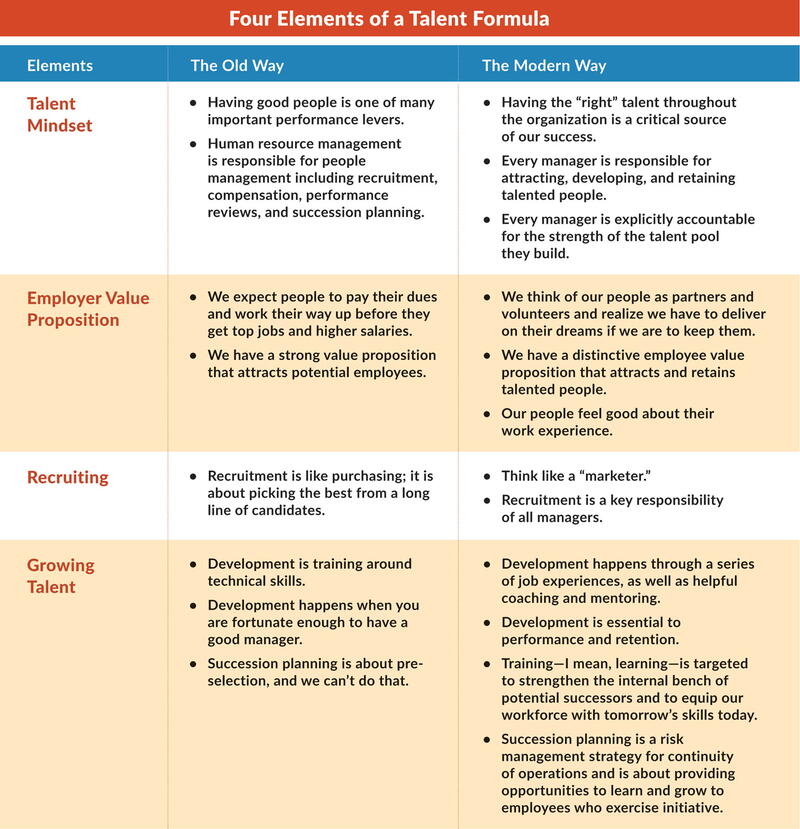
By Patrick Ibarra
“When we have arrived at the question, the answer is already near.” —Ralph Waldo Emerson
This is my second of a four-part series in which I focus on the impacts of the numerous changes impacting the role of local government. In this article, I identify why developing a talent-centric workforce is mission critical to your organization’s effectiveness. In brief, to build a twenty-first century workforce, you must implement a twenty-first century approach!
Turbulence surrounds both today’s workforce and workplace, especially in local government. The workforce and workplace of tomorrow will be very different from those of today. Organizations need specific skills and attributes from their leaders, and for that matter, from those at all levels of the workforce. Employees will have markedly different needs and preferences, and workers will have different views based on their experiences, culture, ethnicity, and education. Workflows and work processes will change, and, for knowledge workers, the workplace is as likely to be remote as the office.
The impacts from the COVID-19 virus on budgets for local governments has yet to be realized, but it likely will be significant and suggests some questions to ponder:
- Might we have to implement a hiring freeze, or at a minimum, a chill?
- Will our seasoned employees retire as pension reform looms?
- What will the impact be to the effectiveness of our organization should seasoned employees retire and our ability to replace them be constricted?
- Will our budget for employee learning and development be maintained, if not, increased?
- How do we position our organization as a modern employer should hiring continue?
- How can we prepare our workforce for the challenges and opportunities associated with changes underway?
- How can we develop employees to ensure that we have qualified candidates (i.e., strong internal bench) ready to fill those key positions when a vacancy occurs?
These are just some of the questions leaders in local government may have to address as they translate the impacts from a number of changes, including the COVID-19 virus on their workforce and ability to sustain high-quality service delivery.
Additionally, there are demographic shifts occurring:
- Globally more people are over 65 than under five for the first time; in the United States, more people are older than 60 than under 18.Each day, 10,000 people turn 65 years of age. According to the Pew Research Center, for the first time, millennials now outnumber baby boomers in the workplace 76 million to 75 million. Millennials comprise one-third of the current workforce at 53.5 million; and by 2025, they will make up 75 percent of the workforce.
- The millennial generation has different work motivations and expectations for greater work/life balance.
- The workforce will be more culturally and ethnically diverse and include more highly educated women, military veterans, and people with disabilities.
- Expectations are likely to increase for customized benefits, mobility of benefits, and flexible work options.
- The historical, long-term arrangement between employer and employee—sometimes referred to as “life-time employment,” where the employer provides steady employment, attractive benefits, and wages in exchange for an employee’s long-term effort and tenure—is changing to one more akin to the private sector.
- More widespread desire for work with a purpose and opportunities to influence the way it is delivered (for example, greater team autonomy).
- The digital workplace and the rise in mobile technology are redefining the nature of work and the means of collaboration, facilitating work in and from almost any location.
- New technologies that replace human labor, threatening employment (such as driverless trucks).
- General increase in the skills, technical knowledge, and formal education required to perform work.
Organizations face a radically shifting context for the workforce, the workplace, and the world of work. These shifts have changed the rules for nearly every organizational people practice, from learning to management to the definition of work itself. As jobs and skills change, attracting and developing the right people become more important than ever.
Improving (or simply maintaining) workforce productivity requires you to accept that the work environment has changed, and your approach to talent management must change as well. Talent management has become one of the most pressing topics in organizations and its long overdue for the public-sector to transition its mindset from employees to talent. Your organization’s talent is not just employees who are expected to do a job (or for that matter, a role); talent comprises individuals who differ in what they can do and can learn, and what they want to do. To be effective, you need to manage talent in ways that make it a major contributor to your organization’s success.
Talent drives success, but the talent practices many governments use are vestiges of another era. They were designed for predictable environments, traditional ways of getting work done, and organizations where lines and boxes defined how people were managed. Modern leaders recognize that talent selection decisions are an increasingly important determinant of organizational performance and success. Those organizations that attract and retain the right kind of talent—and treat it, reward it, develop it, and deploy it correctly—perform better than those that simply fill jobs with people.
Talent management is a systematic approach to performance excellence achieved by creating a culture of continuous improvement, high engagement, and workforce capability and capacity through integrated talent strategies and learning and development programs that are aligned with the agency mission, vision, and core values. Through talent management, achieving optimal performance is influenced more by preparing workforce members to handle present and future challenges and less by simply adding more employees. The adoption and implementation of a talent management process provides the opportunity for leaders to improve organizational performance despite not increasing workforce size.
The following is provided to contrast the old way and modern way of attracting and developing talent:
Employer Value Proposition
Every organization has an employer value proposition (EVP), which communicates your organization’s image to target audiences and reinforces the reasons why talented people would want to stay with or join the organization. Attracting and retaining talent requires an attractive EVP. Providing competitive salaries and benefits is necessary but insufficient if local governments are to attract and retain talent. The war for talent is won on the battlefield of culture and opportunities for employees to learn and grow. An organization’s employee value proposition outlines why a talented employee would consider joining and staying with an organization. An employee value proposition may also suggest why a talented employee would be reluctant to join or stay with an agency.
Local government has a good product to offer, especially to next generation talent: meaningful, challenging jobs and the opportunity to make a difference, build community, and even save the planet. The problem is that many of the human resource and other organizational practices are not aligned with next generation values. The long periods to hire staff, boring job listings, noninteractive career websites, rigid job descriptions, stagnant learning environments, stale workplace culture, and lack of opportunity to influence decision-making undercut the ability of many traditional local governments to attract and keep talent.
Having an attractive careers website was a prerequisite 10 years ago, but it’s time to up your game. Not only must you use your site as a platform to showcase what makes you special to potential candidates, you also need to carry the brand message through all your marketing materials, across social media changes and in the stories, you share in person. For example, written and video testimonials should be posted on the website and social networks from current employees explaining why they enjoy their jobs. Doing so will create an image among prospective hires of what it’s like to work for you. This type of marketing is referred to as social marketing and is becoming increasingly common for public-sector organizations.

Succession Planning
I have authored numerous articles on the subject of succession planning, spoken at scores of conferences, and designed and implemented succession planning processes for a large number of cities and counties across the nation.
Regardless of the size of your organization, you currently have an approach for succession planning, but if it is not methodical and replicable, the results are not sustainable. Improving workforce productivity requires organization leaders to accept that the work environment has changed, and their approach to succession planning must change as well.
Many forward-looking organizations are pursuing comprehensive and systematic succession planning to ensure their organization can lose seasoned, knowledgeable employees without experiencing a disruption in service delivery. More than just training employees, succession planning is both about developing talent inside the organization and implementing ways to recruit more qualified candidates to join the organization. Furthermore, succession planning is not simply replacing positions that become vacant; it’s a dynamic process of aligning employee aspirations and talents with the constantly evolving needs of the organization and providing employees with the resources and support they need to grow into new roles.
In its most impactful form, succession planning influences how people across the organization think about performance, potential, job assignments, career paths, staffing decisions, and employee development. In short, it’s about matching your organization’s resources with employee initiative.
A wider definition of succession planning should also include:
- Ensuring the people who join the organization are compatible with the fit required to be successful and while not all may be interested in pursuing a promotion at some point, a sufficient number are willing to invest their time, effort, and energy to position themselves for those opportunities.
- Making sure that there are enough suitable people to step into any significant role as it becomes vacant or is created.
- Motivating and developing them to adapt to the new role as fast as possible with minimum disruption.
- Recognizing that roles and their incumbents are constantly evolving.
Effective succession planning relies on organizations to provide opportunities and proactive suggestions for development that increases the readiness of employees for future positions. By linking learning and development with succession and career planning, you can positively impact the availability of talent to meet future requirements.
Training
The third and final area that is mission-critical to maintaining a talent-centric workforce is training. By the way, it’s way past time to replace the word training, which is an expense, with the word learning which is an investment.
Most government organizations invest a majority of their learning/training budget in employees’ technical performance. However, the ability to be an outstanding technical performer does not always translate in the ability to be an effective manager. The performance of managers today is rated as much on people skills as on measurable output. In addition, the ability to solve problems, resolve conflict, participate on teams, and make decisions are performance needs that frontline staff and mid-managers require. Although people differ in their baseline abilities, the research shows that skills-based training can result in better results for most people who want to improve their effectiveness.
To deepen the capabilities of your workforce members, you need to have a bottom-to-top leadership and management development program with the following recommended objectives:
- Build the critical leadership competencies of supervisors, managers, and directors.
- Increase productivity.
- Enhance the organization’s capacity to handle strategic, complex, and critical issues in the future.
- Identify potential successors for key executives and leadership roles who will carry on the mission and values of your organization.
The learning and development program should encompass three levels to categorize, in broad terms, the experiences, exposure, behaviors, and awareness of employees—emerging/beginning leaders, intermediate leaders, and advanced leaders.
Development of the workforce cannot be successful as an HR initiative; to have a real impact, it needs to be an organization imperative. To reap the rewards of a stronger focus on leadership, it needs to be owned by senior management, driven by every single manager, and treated like a high priority. In other words, when senior leaders are actively involved in leadership development, the quality is much higher. Senior management has a critical perspective in identifying the leaders the organization needs in the future, but they also have the influence needed to put development at the top of the priority list.
Talent tools and processes your organization has used for decades need to change to reflect the modern workplace and workforce. Everything starts with mindset. Referring to your organization’s vision, mission, and values, the question should be how does talent support or enable all of that? It’s the connective tissue that links it all together.
Local governments must operate in a legacy world, meaning that you must be able to keep doing the nuts-and-bolts work at the core of the mission, but you also must be ready to succeed in a fast-changing environment, one that’s difficult to predict.
Get started now! After you finish reading this article, write down the first three actions you intend to take to accelerate the transition from the workforce you have to the workforce you need.

New, Reduced Membership Dues
A new, reduced dues rate is available for CAOs/ACAOs, along with additional discounts for those in smaller communities, has been implemented. Learn more and be sure to join or renew today!
